“Global Commerce Cloud Market to reach a market value of USD 81.6 Billion by 2031 growing at a CAGR of 22.3%”
The Global Commerce Cloud Market size is expected to reach $81.6 billion by 2031, rising at a market growth of 22.3% CAGR during the forecast period.
The Asia Pacific region is experiencing significant growth in e-commerce, driven by increasing internet penetration, smartphone adoption, and changing consumer behaviors. These cloud solutions are essential for managing large transactions and providing a seamless online shopping experience. Consequently, the Asia Pacific region would acquire nearly 30% of the total market share by 2031.
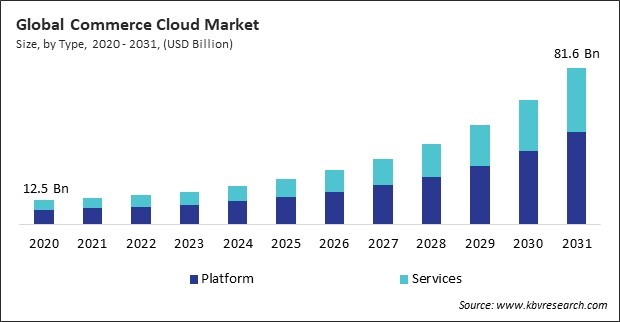
The major strategies followed by the market participants are Partnerships as the key developmental strategy to keep pace with the changing demands of end users. For instance, In January, 2024, Amazon teamed up with Salesforce Commerce Cloud. This collaboration aims to enhance e-commerce capabilities by combining Amazon’s vast marketplace with Salesforce’s cloud-based commerce solutions, enabling businesses to better manage digital storefronts. Moreover, in June, 2024, Shopify has teamed up with Razorfish to push forward the future of unified commerce. This collaboration focuses on integrating various retail channels to deliver a seamless and cohesive shopping experience for consumers.
Based on the Analysis presented in the KBV Cardinal matrix; Microsoft Corporation and Google LLC are the forerunners in the Market. In July, 2024, Microsoft partnered with Commercetools, the API-first e-commerce platform, to bring its services to the Microsoft Azure Marketplace. This partnership aims to provide businesses with advanced, scalable digital commerce solutions on Azure’s cloud infrastructure. Companies such as Amazon Web Services, Inc., Oracle Corporation, SAP SE are some of the key innovators in Market.
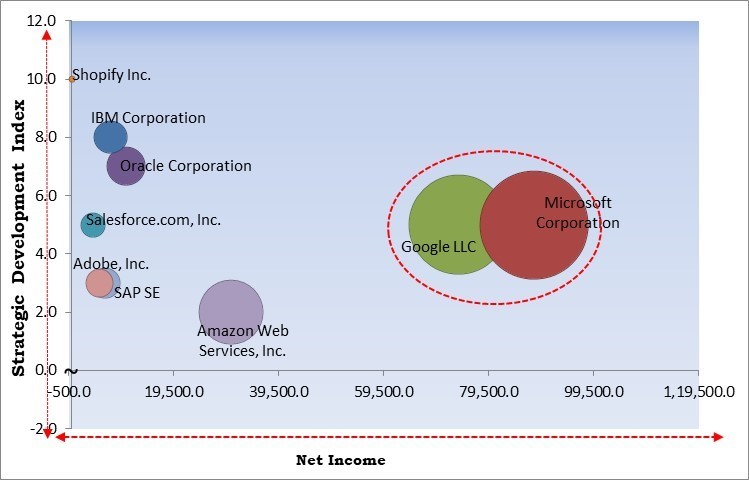
Businesses experience fluctuating demand based on seasonal trends, promotional events, or market conditions. In addition, cloud platforms offer extensive customization options, allowing businesses to tailor their solutions to specific operational needs, branding requirements, and customer preferences. Thus, the demand for scalable, flexible cloud solutions propels the market's growth.
Digital transformation highlights the need for real-time interactions with customers. cloud platforms enable real-time data processing and instantaneous updates to customer-facing systems, facilitating timely responses and interactions that improve customer satisfaction and loyalty. In conclusion, accelerated digital transformation across industries drives the market's growth.
Implementing a cloud solution often involves substantial upfront costs, including setup fees, customization, and integration expenses. cloud solutions typically involve recurring subscription fees based on usage, number of users, or transaction volumes. Hence, high initial investment and ongoing subscription costs hamper the market's growth.
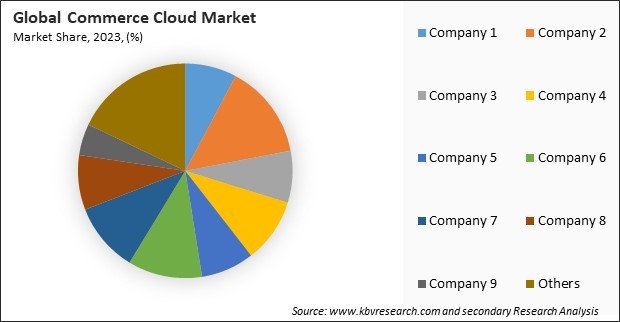
The leading players in the market are competing with diverse innovative offerings to remain competitive in the market. The above illustration shows the percentage of revenue shared by some of the leading companies in the market. The leading players of the market are adopting various strategies in order to cater demand coming from the different industries. The key developmental strategies in the market are Partnerships, Collaborations and Agreements..
Based on type, the market is divided into platforms and services. The services segment attained 39% revenue share in the market in 2023. Businesses require ongoing support and maintenance to ensure their cloud solutions operate smoothly and efficiently. Services such as technical support, updates, and troubleshooting are essential for maintaining system performance and addressing any issues.
On the basis of offering, the market is segmented into private cloud, public cloud, and hybrid cloud. The private cloud segment recorded 15% revenue share in the market in 2023. Private clouds offer higher security, as they are dedicated to a single organization. This is crucial for businesses handling sensitive customer data, financial transactions, and proprietary information, as private clouds provide more control over data security measures and compliance.
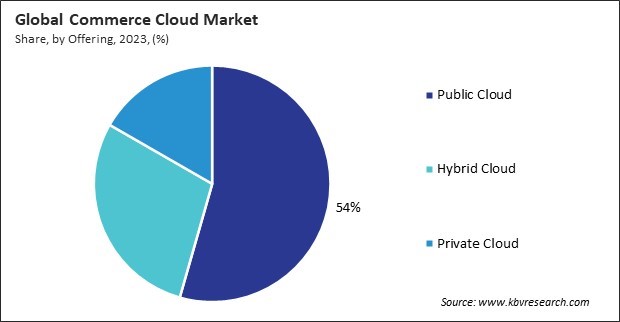
Based on enterprise size, the market is categorized into SMEs and large enterprises. The SME segment witnessed 44% revenue share in the market in 2023. cloud platforms offer advanced features, such as automated marketing, customer relationship management, and analytics tools, which were previously accessible only to larger enterprises.
By vertical, the market is divided into fashion & apparel, electronics & appliances, food & beverages, pharmaceutical & grocery, and others. In 2023, the electronics & appliances segment held 23% revenue share in the market. Electronics and appliance retailers benefit from advanced analytics tools provided by cloud solutions.
Free Valuable Insights: Global Commerce Cloud Market size to reach USD 81.6 Billion by 2031
Region-wise, the market is analyzed across North America, Europe, Asia Pacific, and LAMEA. The North America region witnessed 36% revenue share in the market in 2023. North America has a high rate of technology adoption and digital transformation, with businesses and consumers embracing the latest innovations. The region’s well-developed technological infrastructure supports the widespread use of commerce cloud solutions.
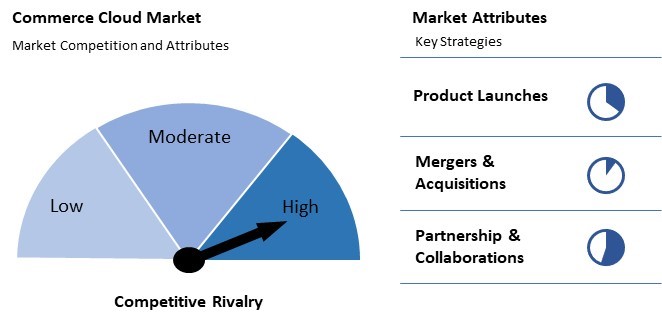
The Commerce Cloud Market is highly competitive, with established players like Salesforce and Adobe facing challenges from newer entrants offering specialized solutions. Key differentiators include scalability, omnichannel integration, and AI-driven personalization, leading companies to innovate rapidly to meet evolving customer expectations and gain a competitive edge.
| Report Attribute | Details |
|---|---|
| Market size value in 2023 | USD 17.1 Billion |
| Market size forecast in 2031 | USD 81.6 Billion |
| Base Year | 2023 |
| Historical Period | 2020 to 2022 |
| Forecast Period | 2024 to 2031 |
| Revenue Growth Rate | CAGR of 22.3% from 2024 to 2031 |
| Number of Pages | 284 |
| Number of Tables | 443 |
| Report coverage | Market Trends, Revenue Estimation and Forecast, Segmentation Analysis, Regional and Country Breakdown, Competitive Landscape, Market Share Analysis, Porter’s 5 Forces Analysis, Company Profiling, Companies Strategic Developments, SWOT Analysis, Winning Imperatives |
| Segments covered | Type, Offering, Enterprise Size, Vertical, Region |
| Country scope |
|
| Companies Included | Oracle Corporation, Salesforce.com, Inc., IBM Corporation, Microsoft Corporation, SAP SE, Shopify Inc., Amazon Web Services, Inc. (Amazon.com, Inc.), Adobe, Inc., Google LLC and BigCommerce Inc. |
By Type
By Offering
By Enterprise Size
By Vertical
By Geography
This Market size is expected to reach $81.6 billion by 2031.
Demand for scalable and flexible cloud solutions are driving the Market in coming years, however, High initial investment and ongoing subscription costs restraints the growth of the Market.
Oracle Corporation, Salesforce.com, Inc., IBM Corporation, Microsoft Corporation, SAP SE, Shopify Inc., Amazon Web Services, Inc. (Amazon.com, Inc.), Adobe, Inc., Google LLC and BigCommerce Inc.
The expected CAGR of this Market is 16.6% from 2024 to 2031.
The Large Enterprises segment led the Market by Enterprise Size in 2023; thereby, achieving a market value of $44.7 billion by 2031.
The North America region dominated the Market by Region in 2023, and would continue to be a dominant market till 2031; thereby, achieving a market value of $28.2 billion by 2031.
Our team of dedicated experts can provide you with attractive expansion opportunities for your business.

 Drivers
Drivers
 Restraints
Restraints
 Opportunities
Opportunities
 Challenges
Challenges
